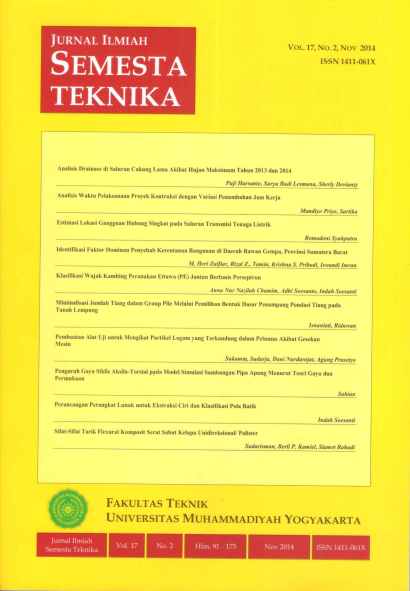Pembuatan Alat Uji untuk Mengikat Partikel Logam yang Terkandung dalam Pelumas Akibat Gesekan Mesin
DOI:
https://doi.org/10.18196/st.v17i2.422Abstract
One of the factors that can affect to the quality of lubricantion is metal particle content due to friction of engine parts. Metal particle in lubricanting oil could damage the engine parts, so it is neccessary to reduce the metal particle content which mingled in lubricant oil. The experiment was conducted in laboratory scale using power magnetic type ring neodymium possessing diameter of 19 mm and thickness of 2 mm. The experiment was conducted by flowing the lubricanting oil containing metal particle continually and put the magnets in engine so that the metal particle will be taken up by the magnets. The experiment used three variations of time (5, 10 and 15 minutes) and three variations of valve to controlling the flow rate using. The highest absortion of metal particle was reached on opening valve 30 for 15 minutes. When volume the flow rate was 200 ml/s and the time was 15 minutes the result of absortion was 7.48 % (magnet A), meanwhile for volume the flow rate 180 ml/s and the time was 15 minutes resulted in particle absortion of about 7.37 % (magnet B). When Magnet A and B used together and at the same flow rate and time, i.e. 180 ml/s time 15 minutes, resulted the particle absortion about 17.98 %.
Downloads
Published
How to Cite
Issue
Section
License
Semesta Teknika is licensed under a Creative Commons Attribution 4.0 International License.
Authors who publish with this journal agree to the following terms:
- Authors retain copyright and grant the journal right of first publication with the work simultaneously licensed under a Creative Commons Attribution License that allows others to share the work with an acknowledgement of the work's authorship and initial publication in this journal.
- Authors are able to enter into separate, additional contractual arrangements for the non-exclusive distribution of the journal's published version of the work (e.g., post it to an institutional repository or publish it in a book), with an acknowledgement of its initial publication in this journal.
- Authors are permitted and encouraged to post their work online (e.g., in institutional repositories or on their website) prior to and during the submission process, as it can lead to productive exchanges, as well as earlier and greater citation of published work (See The Effect of Open Access).









